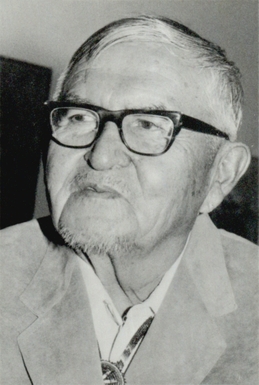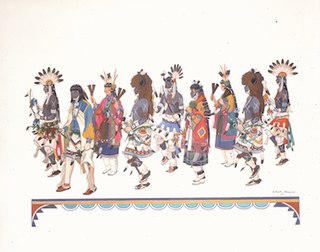Related Research Articles
Oscar Howe was a Yanktonai Dakota artist from South Dakota, who became well known for his casein and tempera paintings. He is credited with influencing contemporary Native American art, paving the way for future artists. His art style is marked by bright color, dynamic motion and pristine lines.

Allan Capron Houser or Haozous was a Chiricahua Apache sculptor, painter, and book illustrator born in Oklahoma. He was one of the most renowned Native American painters and Modernist sculptors of the 20th century.

Fritz William Scholder V was a Native American artist. Scholder was an enrolled member of the La Jolla Band of Luiseno Indians, a federally recognized tribe of Luiseños, a California Mission tribe. Scholder's most influential works were post-modern in sensibility and somewhat Pop Art in execution as he sought to deconstruct the mythos of the American Indian. A teacher at the Institute of American Indian Arts (IAIA) in Santa Fe in the late 1960s, Scholder instructed prominent Native American students.

Tommy Wayne Cannon was an important Native American artist of the 20th century. He was popularly known as T. C. Cannon. He was an enrolled member of the Kiowa Indian Tribe of Oklahoma and had Caddo and French ancestry.

Pablita Velarde born Tse Tsan was an American Pueblo artist and painter.
René d'Harnoncourt was an Austrian-born American art curator. He was Director of the Museum of Modern Art, New York, from 1949 to 1967.
Paul Burlin was an American modern and abstract expressionist painter.

Fred Kabotie was a celebrated Hopi painter, silversmith, illustrator, potter, author, curator and educator. His native name in the Hopi language is Naqavoy'ma which translates to Day After Day.

Charles Sequevya Loloma was a Hopi Native American artist known for his jewelry. He also worked in pottery, painting and ceramics.

Martha Hopkins Struever (1931–2017) was an American Indian art dealer, author, and leading scholar on historic and contemporary Pueblo Indian pottery and Pueblo and Navajo Indian jewelry. In June 2015, a new gallery in the Wheelwright Museum of the American Indian, was named for her. The first permanent museum gallery devoted to Native American jewelry, the Martha Hopkins Struever Gallery, is part of the Center for the Study of Southwestern Jewelry.

Velino Shije Herrera, also known as Ma Pe Wi, was a Zia Pueblo Indian painter.

Tonita Peña born as Quah Ah but also used the name Tonita Vigil Peña and María Antonia Tonita Peña. Peña was a renowned Pueblo artist, specializing in pen and ink on paper embellished with watercolor. She was a well-known and influential Native American artist and art teacher of the early 1920s and 1930s.
Lloyd Henri Kiva New was a pioneer of modern Native American fashion design and a cofounder and president emeritus of the Institute of American Indian Arts (IAIA) in Santa Fe, New Mexico.
Frederic Huntington Douglas also known as Eric Douglas. "was one of the first scholars to recognize the artistic achievements of American Indians as well as the arts of Africa and Oceania."
Yeffe Kimball, born Effie Goodman, was an American artist known for her abstract modernist work with Native American and space exploration subjects. Kimball created work under an assumed Osage Indian identity, rising to prominence after her admittance of the painting Sacred Buffalo into the Philbrook Museum of Art's first Indian Annual in Tulsa, Oklahoma, in 1946.
Joe Hilario Herrera, was an American Pueblo painter, teacher, radio newscaster, politician, and a Pueblo activist; from a mixed Cochiti and San Ildefonso background. He was the son of the artist Tonita Peña, and had trained at the Santa Fe Indian School.

Gilbert Benjamin Atencio, also called Wah Peen, was a San Ildefonso Pueblo painter, potter, medical Illustrator, and politician.
Mitchell (Mitch) Armitage Wilder was an American mid-20th century arts administrator, scholar, and photographer. Between 1935 and 1961 he was the founding curator or director of three art museums: the Taylor Museum of the Colorado Springs Fine Arts Center, the Abby Aldrich Rockefeller Folk Art Museum at Colonial Williamsburg, and the Amon Carter Museum of American Art in Fort Worth, Texas. Additionally, as director of the Chouinard Art Institute, Wilder facilitated the incorporation of that school for animators into the California Institute of the Arts.
Otis Polelonema (1902–1981), was a Hopi painter, illustrator, weaver, song composer, and educator. He lived in Shongopovi most of his life. He also worked as a WPA artist in the mural division. His native name in the Hopi language is Lomadamocvia which translates to "springtime".
References
- 1 2 "Indian Art of the United States, January 22-April 27, 1941". Museum of Modern Art. Retrieved March 9, 2017.
- 1 2 3 4 curator, catalogue by Beverly Gordon with Melanie Herzog ; exhibition organized by the Elvehjem Museum of Art ; guest; Potter, Beverly Gordon with Frances; Herzog, Melanie (1988). American Indian art : the collecting experience : Elvehjem Museum of Art, University of Wisconsin-Madison, May 7-July 3, 1988. [Madison]: Elvehjem Museum of Art. p. 10. ISBN 9780932900180.
{{cite book}}: CS1 maint: multiple names: authors list (link) - ↑ Berlo, Janet (2015). "The art of Indigenous Americans and American art history: a century of exhibitions". Perspective (2). doi: 10.4000/perspective.6004 . Retrieved March 9, 2017.
- 1 2 3 4 5 6 7 8 "Exhibition of Indian Art of the United States Opens At Museum of Modern Art" (PDF). Museum of Modern Art. Retrieved March 9, 2017.
- ↑ "The Museum of Modern Art Press Release - January 20, 1941" (PDF). Museum of Modern Art. Retrieved March 6, 2017.
- ↑ Anthes, Bill (2006). Native moderns : American Indian painting, 1940-1960. Durham: Duke University Press. p. 17. ISBN 9780822338666.
- ↑ Anthes, Bill (2006). Native moderns: American Indian painting, 1940-1960. Durham: Duke University Press. p. 19. ISBN 9780822338666.
- ↑ Valliant, George. "Indian Art of the United States: An Exhibition at the Museum of Modern Art". JSTOR 3046754E.
{{cite journal}}: Cite journal requires|journal=(help) - ↑ "Records of the Indian Arts and Crafts Board". Archives.gov. August 15, 2016. Retrieved March 9, 2017.
- ↑ Staniszewski, Mary Anne (1998). The power of display : a history of exhibition installations at the Museum of Modern Art (Pbk. ed.). Cambridge, Mass.: MIT Press. ISBN 978-0262194020.
- ↑ Douglas, Frederic Huntington (1941). Indian Art of the United States . New York: Museum of Modern Art. p. 219.
- ↑ Kastner, Georgia O'Keeffe Museum ; edited by Carolyn (2014). Miguel Covarrubias : drawing a cosmopolitan line (First ed.). Univ of Texas Pr. pp. 76–99. ISBN 978-0-292-76048-6.
{{cite book}}:|first1=has generic name (help)CS1 maint: multiple names: authors list (link) - ↑ Stark, Gregor; Baldinger, E. Catherine Rayne ; ed. by Jo Ann (1998). El Delirio : the Santa Fe world of Elizabeth White (1st ed.). Santa Fe, N.M: School of American Research Press. ISBN 978-0933452527.
{{cite book}}: CS1 maint: multiple names: authors list (link) - ↑ Rushing, W. Jackson (1995). Native American art and the New York avant-garde : a history of cultural primitivism (1st ed.). Austin: University of Texas Press. ISBN 978-0292755475. OCLC 30318774.
- ↑ Anthes, Bill (2006). Native moderns : American Indian painting, 1940-1960. Durham: Duke University Press. p. 61. ISBN 9780822338666.
- ↑ Deutch, Jack Flam with Miriam, ed. (2003). Primitivism and twentieth-century art : a documentary history. Berkeley: University of California Press. p. 261. ISBN 9780520215030.